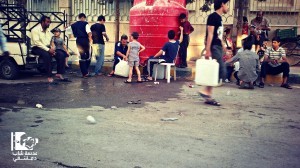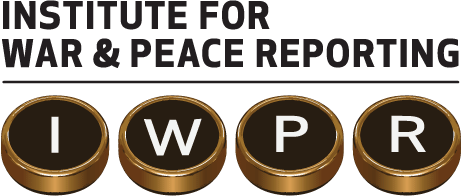Refugees Struggle with Health Issues

Note: All names have been changed for the safety of the interviewees.
(Sahnaya, Syria) – Wael, 8, walks with a limp – the result of a pin lodged in the sole of his foot which went untreated for so long that it caused an infection and serious swelling.
“My mother can’t take me to the doctor because she doesn’t have any money,” he said. “She already had to borrow money from our relatives to treat my twin brother when he got a severe rash all over his body.”

The second-grader explains that his brother succumbed to the skin disease as a result of the stress and terror he experienced when bombs fell on the Sbineh refugee camp, south of Damascus, killing several children before his eyes.
According to Wael’s mother, his policeman father was killed in Sbineh by the Free Syrian Army in March 2012 after he refused to revolt and join their cause.
Wael’s mother was then forced to flee with her five children to the Khan Dannoun camp, further south on the road to Daraa.
She works as a cleaner in the nearby town of Sahnaya, as the pension she receives following her husband’s death is not enough to provide for her family’s needs.
The fierce fighting and the siege imposed by regime forces have forced many people to flee the areas of Hajira and al-Hajar al-Aswad, as well as the Sbineh, Yarmouk and Falasteen camps which house mainly Palestinian refugees, all south of Damascus.
Like Wael’s family, most sought shelter in safer nearby towns, such as Sahnaya, Khan Dannoun and Kiswa.
A large number of the refugees are vegetable sellers, street vendors or construction workers. Most have lost these sources of meagre income as well as their family’s main earners, leading to a drop in their standards of living that in turn affects their health.
Ayat’s situation is a prime example. The 10-year-old girl and her family live in a two-room rented house in Sahnaya with one kitchen and one bathroom, which they share with her uncle’s family, her grandmother and three aunts, all of whom have fled al-Hajar Al-Aswad. The rent is 25,000 Syrian liras, 220 US dollars, a sum that is not easy to provide in these circumstances.
“My turn to shower comes only twice a month, because there isn’t enough water for everyone and it’s too expensive to buy more,” said Ayat. She feels deep embarrassment over the fact that her schoolmates refuse to sit next to her or play with her because she has lice.
Mona, 41, a maths teacher at Ayat’s school, explains that there’s a general spread of contagious skin ailments among the displaced children.
“There is a lot of lice, as well as other skin diseases like scabies, because so many families are cramped together in small houses so as to be able to afford the rent, which makes any infection spread very quickly among them,” said Mona. “The students then bring the infection to school and spread it to their schoolmates, who then take it home with them. And the spread of the infection just gets wider and wider.”
Apart from skin disorders and conditions such as diabetes or anaemia, many refugees increasingly suffer from shock and other psychological problems as a result of the violence they have witnessed. The mother of Salam, 15, says that her daughter was traumatised by the loss of her father.
“My daughter started to show signs of psychological problems when her father, to whom she was very attached, died suddenly,” she said. “She would begin crying hysterically and tearing off her clothes, even if she was out in the streets, flinging insults and curses at everyone, especially at her absent father and at me, even though I’m doing my best to understand and protect her.”
“We started to become afraid of her,” said Salam’s younger sister, Israa, 13. “She tried to hang our younger siblings, in imitation of an incident she witnessed at Falasteen camp when some regime spies were publicly hung.”
These days, Salam lives at her uncle’s house most of the time, where she is forcibly restrained and forbidden from tearing off her clothes. Her uncle’s wife and grown daughters take care of her, allowing her to return to her mother’s house when she is calm. Her family has taken her to the hospital more than once, but they say that no medication prescribed for her there has helped.
Dr Ayham works at a government health centre in Kiswa that gives free medical care to its patients. The doctor says that the centre provides polio vaccines on a regular basis, but the rest of their medical services are too limited to meet the needs of the huge number of impoverished, displaced people who are often unable to buy prescribed medications or undergo the required tests.
As they cannot afford rental prices, many refugees in Sahnaya live in the skeletons of half-finished buildings, in rooms with ceilings and walls but no doors or windows.
Mohsin, 55, a vegetable seller who is currently unemployed, lives in one of these incomplete houses without running water or electricity.
He’s sealed the doors and windows with cloth and plastic sheeting.
“It’s normal that we’re all sick all the time,” he said. “My wife began showing the symptoms of asthma because the place we’re in is so damp, and my children are constantly ill with colds.”
Mohsin depends on the aid distributed by government bodies and NGOs as well as some other donations, but says that all of these combined can barely sustain his family in light of the high prices.
Dr Rola works in a non-governmental health centre in Sahnaya, established by a number of doctors on their own initiative to provide free medical care to poor refugees.
She says that most of the patients at the centre suffer from anaemia and malnutrition, especially the children, which affects their mental and physical development, in turn impacting their schoolwork and their future.
Dr Rola called for all who work in the field of relief, whether in the government or in organisations such as the Red Crescent, UNRWA or other charities, focus more attention on the plight of the displaced in the areas south of Damascus.
